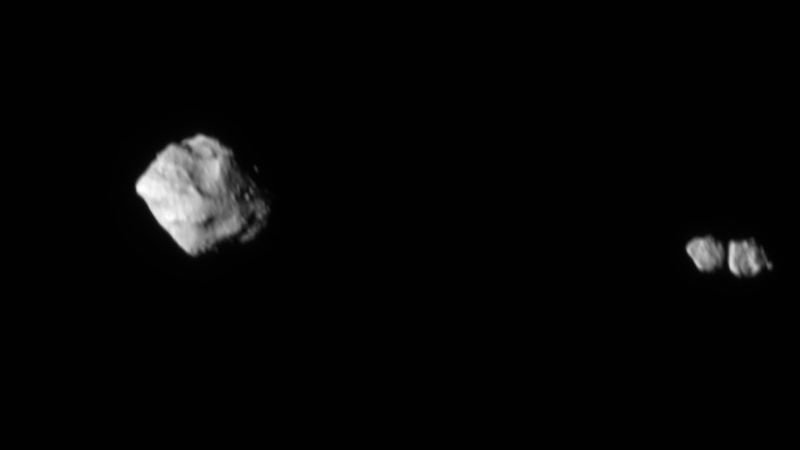NASA/Goddard/SwRI/Johns Hopkins APL
The Lucy mission captured additional images that reveal that asteroid Dinkenish (left) has an attached binary companion, or two space rocks touching each other.
Sign up for CNN’s Wonder Theory science newsletter. Explore the universe with news of fascinating discoveries, scientific advances and more.
CNN
—
Dinkenish, a small asteroid visited by NASA’s Lucy mission last week, continues to raise eyebrows.
Lucy swung by the space rock, located in the main asteroid belt between Mars and Jupiter, on November 1 as part of a test of the spacecraft’s equipment before tackling the mission’s primary goal: surveying swarms of Trojan asteroids around Jupiter. Dinkenesh, which means “awesome” in the Ethiopian Amharic language, was not added to Lucy’s itinerary until January.
But the first observations taken by Lucy’s instruments showed that there was more to the mysterious asteroid than expected. Initially, the pictures indicated that The space rock was part of a binary pairWith a smaller asteroid orbiting Dinkenish.
NASA/Goddard/SwRI/Johns Hopkins APL/NOIRLab
The first image taken by the spacecraft during its closest approach revealed the companion, but not the fact that it was a contact binary.
However, additional images taken by the spacecraft after its closest approach revealed that the smaller asteroid is actually a contact binary — two small space rocks touching each other.
Lucy came within 265 miles (about 425 kilometers) of the asteroid’s surface during its closest approach, which is when the first images were taken. The second batch of images revealing the duo’s contact, shared by NASA on Tuesday, were captured six minutes later from a distance of 1,010 miles (about 1,630 kilometers).
“Contact binaries appear to be fairly common in the solar system,” John Spencer, deputy project scientist for Lucy at Southwest Research Institute, said in a statement.
“We haven’t seen many of them up close, and we’ve never seen one orbiting another asteroid.
We were puzzled by the strange variations in Dinkenish’s brightness that we saw on approach, which gave us a hint that Dinkenish might have a moon of some sort, but we never suspected anything so strange!
The close approach was designed primarily to help the Lucy spacecraft test its final tracking system, which allows the spacecraft to autonomously locate the space rock and keep it within view while flying at 10,000 miles per hour (4.5 kilometers per second). The system exceeded expectations, allowing astronomers to discover Dinkenish’s unexpected companion.
NASA/Goddard/SwRI
This graphic shows the path of the Lucy spacecraft as it flew by Dinkenish and as it took images it revealed the surprising asteroid companion.
“It is puzzling, to say the least,” Hal Levison, the principal investigator on Lucy at the Southwest Research Institute, said in a statement. “I never expected a system to look like this. In particular, I don’t understand why the two components of the satellite are so similar in size. It would be interesting for the scientific community to discover.”
Data from the flyby is still transmitted from the spacecraft to the mission team.
“It’s truly wonderful that nature can surprise us with a new mystery,” Tom Statler, NASA’s Lucy program scientist, said in a statement. “Great science pushes us to ask questions we didn’t know we needed to ask.”
Lucy’s next close encounter will be with another main belt asteroid called Donald Johansson in 2025. After that, the spacecraft will set off to see the Trojans.
The Trojan asteroids, which borrow their name from Greek mythology, orbit the Sun in two swarms – one preceding Jupiter, the largest planet in our solar system, and the other trailing behind it. The asteroids are too far away to be seen in detail with telescopes, and they’ll get close-up images when Lucy reaches the Trojans in 2027.
The mission borrows its name from Lucy fossilthe remains of an ancient human ancestor that was discovered in Ethiopia in 1974. The skeleton has helped researchers piece together aspects of human evolution, and members of NASA’s Lucy team hope their mission will accomplish a similar feat regarding the history of our solar system.
Asteroids are like fossils themselves: they represent the material left over from the formation of the giant planets in our solar system, including Jupiter, Saturn, Uranus, and Neptune.

“Typical beer advocate. Future teen idol. Unapologetic tv practitioner. Music trailblazer.”






More Stories
‘It gave me goosebumps’: The most powerful gamma-ray burst ever observed was hiding a secret, scientists say
NASA’s Perseverance rover has found a rock on Mars that may indicate ancient life.
Northern Lights May Shine in Some States Tonight